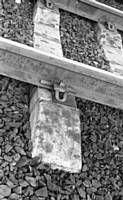A History of Castleton Long Welded Rail Depot
Castleton Rail Welding Depot 1960 to 2010
Traditionally railway track was constructed from individual rail lengths which gradually increased from the 6 foot of earliest days to 15, 30, 45 and ultimately 60 foot. During the 1939-45 war some rail came from the USA. As the Liberty Ships holds were in 40 foot sections, the longest rails which could be transported were 39 foot. On arrival some at least of these were welded together to form 78 foot rails. I have seen these 78 footers still in service on the Keighley & Worth Valley Railway and on the Watercress line.
Traditionally in Britain a “bullhead” design of rail was universally used on main lines but after 1948 a “flat bottom” section was adopted and gradually became standard The use of flat bottom rail was practically universal in the rest of the world. Much of the cost of track maintenance was related to the joints where the fishplate bolts were always tending to work loose. Rails were allowed to move slightly in the fishplates to allow for expansion and contraction in hot or cold weather.
In the late 1950s, British Railways started experimenting with longer lengths of rail formed of 60 foots welded together. This meant fewer joints but these experiments were not always successful. Eventually however a design standard was developed and the first installations of long welded rail, (also known as continuous welded rail abbreviated as “cwr”) went into service in early 1960.
British Railways’ first cwr depot was at Castleton in Lancashire. Rails were delivered in 60 foot lengths from Workington and welded into 600 foot lengths. The first installation was appropriately at Castleton itself, in the down line towards Rochdale where the technicians could keep a close eye on it. This was in early April 1960.
Cwr is laid on substantial concrete sleepers which anchor the track and resist any tendency to expand in hot weather… In early installations it was usual to install a breather segment which would allow limited lengthwise expansion.
Quality control was of the highest importance and something like 10 per cent of all welded joints were cut out and subject to destructive testing by dropping heavy weights on to the welded joint from a height.
Over the years the method of fixing the rail to the sleeper has had several designs.
The long rails were transported on special trains of bolster wagons and could be off loaded at the end of the train. At first there were concerns about how the trains would negotiate sharp curves and the loaded trains were sent out in charge of class 08 diesel locomotives which had a maximum speed of 15 mph. For obvious reasons they ran overnight. Gradually it was realised that transporting the long lengths was safe and the trains were permitted to run at increased speeds. The last specially built trains had four decks each of twelve lengths of rail making a total of 48 pieces of cwr.
In steam days the returning empty trains often had unusual locomotives in charge, occasionally even the odd Royal Scot.
Castleton depot closed in 2010 and the plant moved to Scunthorpe.
(Both photographs of track in the down main line at Castleton 27 April 1960.)
Richard S Greenwood November 2016
